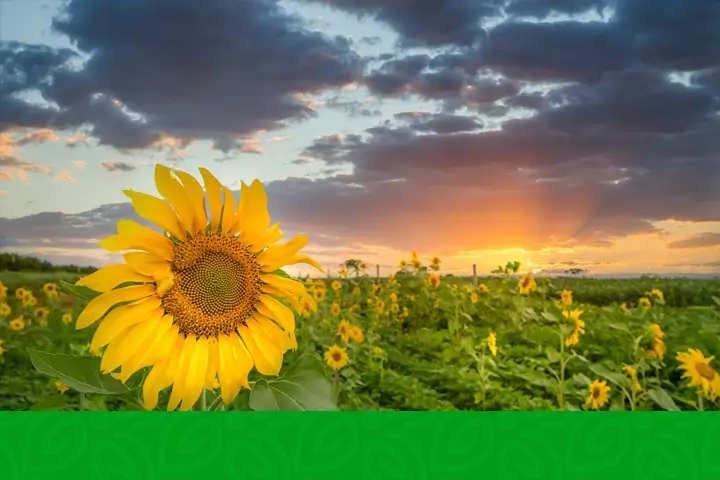
In the vast realm of agriculture, few crops captivate our imagination quite like sunflowers. These radiant giants of the field not only bring to life the essence of sunshine but also offer a diverse range of uses, from oil extraction to culinary delights. Embarking on the journey of sunflower farming isn’t just about planting seeds; it’s about cultivating a vibrant ecosystem, fostering sustainable practices, and reaping the rewards of nature’s abundance. This comprehensive guide will be your companion through the intricate tapestry of sunflower farming, providing you with descriptive insights and real-world examples that will help you cultivate success from seed to harvest.
1. Choosing the Right Variety: Selecting Your Palette
Just as an artist carefully selects their color palette, a farmer must choose the right sunflower variety for their canvas. The choice of variety can make a significant impact on your farm’s success:
High-Yield Varieties: Imagine fields adorned with towering sunflowers, each bursting with seeds. High-yield varieties like ‘AGCORN Hybrid 6429’ can ensure a plentiful harvest, offering both economic benefits and a sense of accomplishment.
Adaptation to Climate: Picture sunflowers thriving under the warmth of the sun, resilient against local climate challenges. Opt for varieties like ‘Autumn Beauty’ or ‘Giant Sungold’ that are well-suited to your region’s temperature, rainfall, and growing conditions.
2. Soil Preparation: Setting the Stage
Just as an artist primes their canvas, a farmer must prepare the soil for sunflower planting:
Well-Drained Soil: Visualize the soil as a canvas, ready to receive the seeds. Sunflowers thrive in well-drained soil with a loamy texture, ensuring that excess water doesn’t impede their growth.
Soil Testing and Amendments: Picture a farmer conducting a soil test, revealing the composition and nutrient content. Amend the soil as necessary, adjusting pH levels and enriching it with organic matter and essential nutrients.
3. Sowing the Seeds: The First Brushstroke
Sowing sunflower seeds is like placing the first brushstroke on a blank canvas – it sets the stage for the masterpiece to come:
Spacing: Imagine neat rows of sunflowers, each with ample space to breathe and flourish. Plant seeds with a spacing of 2 to 3 feet apart, allowing for optimal sunlight exposure and airflow.
Planting Depth: Visualize seeds being gently tucked into the soil, ready to germinate. Plant sunflower seeds at a depth of about 1 to 1.5 inches, ensuring they’re adequately covered.
4. Nurturing Growth: Painting the Landscape
Nurturing sunflowers is akin to watching your landscape come to life as the plants grow and thrive:
Watering: Picture sunflower roots absorbing water like a canvas soaking up paint. Maintain consistent soil moisture, avoiding waterlogged conditions that can hinder root development.
Nutrient Management: Imagine a nutrient-rich palette enhancing the sunflowers’ growth. Fertilize the soil with a balanced N-P-K fertilizer, with a focus on phosphorus to encourage robust root growth and flower formation.
Weed Control: Visualize your sunflower field free from competing weeds, much like an artist maintains a clean workspace. Regularly remove weeds to prevent them from robbing your sunflowers of essential resources.
5. The Sunflower Sun Dance: Nature’s Masterpiece
Sunflowers possess a unique ability known as heliotropism – they follow the sun’s path across the sky. This phenomenon is like a natural dance that unfolds daily:
Facing the Sun: Imagine sunflowers turning their heads to track the sun’s movement. This adaptation maximizes their exposure to sunlight, optimizing photosynthesis and aiding in seed development.
6. Disease and Pest Management: Preserving the Masterpiece
Just as an artist preserves their masterpiece from deterioration, a farmer must safeguard sunflowers from pests and diseases:
Companion Planting: Picture sunflowers standing tall amidst a tapestry of marigolds and other companion plants. Marigolds release compounds that deter harmful pests, helping to protect your sunflowers naturally.
Integrated Pest Management: Visualize ladybugs patrolling the sunflower field, keeping aphids in check. Employ beneficial insects like ladybugs, lacewings, and parasitic wasps to manage pests in a balanced and eco-friendly manner.
7. Harvesting the Bounty: Reaping the Rewards
Harvesting sunflowers is like admiring the culmination of your artistic endeavors:
Maturity Check: Picture sunflower heads bowing slightly as they reach maturity. Harvest when the back of the flower head turns from green to yellow, and the seeds inside become plump and mature.
Drying and Storing: Visualize sunflower heads hung in a well-ventilated area, much like artwork hung in a gallery. Allow the heads to dry thoroughly before gently removing the seeds. Store the seeds in cool, dry conditions to maintain their quality.
Cultivating Radiance
Embarking on the journey of sunflower farming is akin to becoming an artist of the land. Just as each brushstroke contributes to a masterpiece, each step of sunflower cultivation plays a crucial role in the final harvest. By fostering sustainable practices, celebrating the beauty of sunflowers, and nurturing a thriving agricultural ecosystem, you’re not just growing crops; you’re crafting a radiant legacy that enriches both the environment and your community. As the sunflowers turn their faces to the sky, they remind us of the enduring connection between nature and artistry, a connection that defines the essence of sunflower farming.
Stay updated with the latest farming tips and agriculture industry news from Africa by subscribing to our newsletter. Don’t miss out on valuable insights and updates. Follow us on Twitter, LinkedIn, and Facebook to join our farming community and stay connected with us.



















